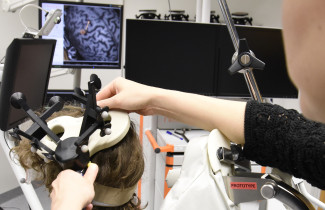By combining magnetic resonance imaging with inverse problems research and machine learning, it is possible to predict properties of tissues that cannot be directly imaged.
Solutions for human well-being through Medical Physics
“I completed my doctoral degree in the University of Kuopio in 2008 on quantitative magnetic resonance imaging of articular cartilage. The topic, magnetic resonance imaging (MRI) seemed very exciting to me years earlier when I was deciding my M.Sc. thesis topic between inverse problems and MRI,” Mikko Nissi, Professor of Medical Physics and Engineering, says.
“The choice was right, as I can hardly imagine a research topic more exciting!”
In the last several years, “the circle has been completed” as a sizable part of his research nowadays concerns inverse problems in magnetic resonance imaging, in close collaboration with the inverse problems group in the same department. Nissi also belongs to the Academy of Finland Flagship of Advanced Mathematics for Sensing, Imaging and Modelling (https://fameflagship.fi/). Besides the flagship, another central scientific home for Nissi is the imaging community comprising of researchers working particularly on magnetic resonance imaging in the UEF.
Magnetic resonance imaging (MRI) is one of the most important medical imaging modalities nowadays and routinely used in hospitals throughout the world.
“MRI has certain benefits, compared to, e.g., X-ray imaging, ultrasound imaging and few others. It is safe by not inducing ionizing radiation, it has excellent resolution and most of all, it is capable of differentiating (i.e. providing image contrast) between various soft tissues,” he says.
According to Nissi, MRI is extremely versatile and enables various ways of performing the imaging, allowing focusing on many different types of tissues and on specific conditions, enabling holistic assessment of, e.g., various pathologies. There are certain limitations, of course, the method is relatively slow for example. On the other hand, there are endless possibilities for further research.
“My research interests include various quantitative MRI aspects, primarily different relaxometry methods, which allow gaining more understanding of the properties of different tissues that are scanned with the MRI method,” Nissi describes.
“A primary focus of my current research concerns combining a rapid, incoherent quantitative MR imaging method with machine learning approaches to predict biological and physical properties of tissues that are not directly measurable using MRI. This research is conducted in collaboration with researchers from University of Oulu, Aalto University and New York University.”
Medical physics and engineering are one of the key areas of importance in the future
Nissi’s current research focuses particularly on assessing the properties of articular cartilage and other musculoskeletal tissues via quantitative magnetic resonance imaging.
“If the research proves to be fruitful, the results will be highly relevant and useful for the diagnosis, and monitoring of osteoarthritis, one of the primary musculoskeletal diseases,” he says.
“Musculoskeletal diseases have been a central theme in my research and I find one of my scientific homes within the musculoskeletal diseases research community of UEF (https://www.uef.fi/en/research-community/musculoskeletal-diseases-mskd).”
Nissi says that medical physics and engineering are one of the key areas of importance in the future. New devices, tools and methods for clinical diagnostics and care emerge continuously and utilize the most modern computational methods, including various machine learning approaches.
“There will be a continuous and raising demand for experts in medical physics and engineering who are knowledgeable in these tools and methods and capable of not only using but developing new devices,“ Nissi says.
“Besides the highly positive outlook on the future job market, the field is extremely interesting, and truly allows one to do meaningful work. Thus, I firmly believe studying medical physics and engineering is, and will continue to be, an excellent choice,“ he continues.
Outside of work, Nissi is interested in all sorts of handicraft, such as woodcraft. Over the last decade or so, 3-D printing has become a new interesting hobby for him and has turned out useful in various ways including research.
“Many small, large and odd parts, spare parts and even “missing” parts that will improve something else can be quickly designed, prototyped and manufactured using 3-D printing. Particularly in research, the possibility to design and print various tools and parts of devices has been incredibly useful and is heavily utilized in my research as well,” Nissi says.
***
MIKKO NISSI
Professor of Medical Physics and Engineering, especially magnetic resonance imaging, since 1.4.2024
PhD, University of Kuopio (UEF), 2008
Adjunct Professor (Docent), University of Eastern Finland, 2015–
Most important positions
Associate Professor, University of Eastern Finland, 2020–2024
Academy Research Fellow, University of Eastern Finland, 2015–2020
Post doc Researcher, University of Oulu, 2014–2015
Research Associate, Center for Magnetic Resonance Research, University of Minnesota, MN, USA, 2011–2014
Post doc Researcher, University of Eastern Finland, 2009–2011
For more information, please contact:
Professor Mikko Nissi, tel. +358 50 595 5517, [email protected]



